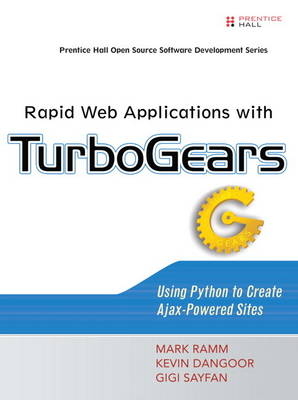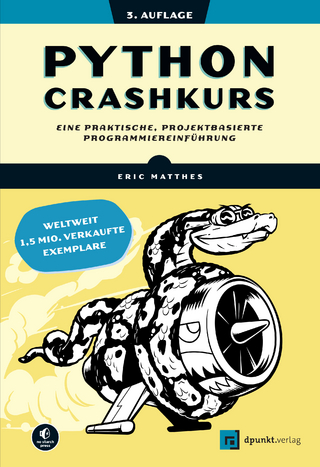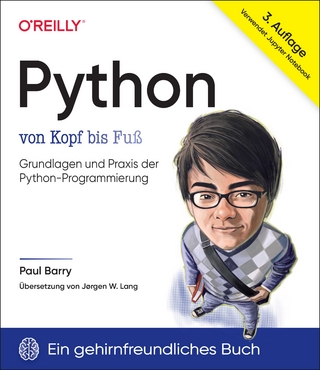
Rapid Web Applications with TurboGears
Prentice Hall (Verlag)
978-0-13-243388-4 (ISBN)
- Titel ist leider vergriffen;
keine Neuauflage - Artikel merken
<>“Dear PHP,
It’s over between us. You can keep the kitchen sink, but I want my MVC.
With TurboGears, I was able to shed the most heinous FileMaker Pro legacy ‘solution’ imaginable. It has relationships based on fields that change frequently, causing ‘disappearing data.’ I replaced it with an easy to maintain TurboGears application. Defunkifying and normalizing many years worth of munged data took twice as long as developing the TurboGears’s application itself. TurboGears’s excellent set of tools and best-of-breed approach makes it so easy to build applications quickly.”
—Isaac Csandl, Manager of Information Technology, Chicago Legal Search, Ltd.
“TurboGears has resulted in significant time savings for rPath. Before it was released, we expected to spend significant time building a Web framework for our rPath Appliance Agent product. TurboGears sharpens our focus on building a quality application; it allows us to provide more value to our customers, rather than reinventing the Web wheel.”
—Michael K. Johnson, rPath Founding Engineer and Coauthor of Linux Application Development, Second Edition
“I think this is the first time that a Web framework’s functionality has been so obvious.”
—Bruce Eckel, Author of Thinking in Java and Thinking in C++
“TurboGears helped me build more complex Web applications more quickly and with fewer headaches than any other framework I’ve used. Just like Python itself, it made me more productive with a minimal learning curve.”
—Quentin Hartman, System Administrator
“TurboGears has changed the way I develop Web applications, from model, to view, to controller. Thanks to the power of TurboGears, I was able to develop the first version of WhatWhat in less than a week of my spare time.”
—Jonathan LaCour, Development Team Lead, Optio
“TurboGears has provided a way for me to greatly enhance my productivity by realizing the potential of Web-based agile development with Python.”
—Brandon Goldfedder, Vice President of Engineering, Information Extraction and Transport (IET Inc.), and Author of The Joy of Patterns
“TurboGears really changed the way I schedule project releases: It allows me to deliver them faster and with better quality than when I used to use GUI toolkits.”
—Jorge Godoy, Owner of G2C Tech Consultoria in Brazil, former Lead Developer for Conectiva documentation team
“With TurboGears, I was able to transition my Python projects into Web applications as easily as possible.”
—Benjamin T. Hamilton, Software Engineer
“Norwegian-based company Scanmine AS makes extensive use of Python and Turbo-Gears in all parts of its operation. TurboGears makes it a breeze to build highly sophisticated Web 2.0 applications with out-of-the-box features for multiple languages with full Unicode, REST, AJAX, RSS/Atom, and more. This enables Scanmine to put a face on their technology development in a minimal amount of time.
“It has been said that there are as many Web frameworks as there are Python Web programmers. This apparent Web framework fragmentation has long been perceived as a weakness, until TurboGears came along and turned weakness into strength.”
—Rune Hansen, Senior Systems Designer, Scanmine AS
“TurboGears is a well thought-out framework; the design choices it has made will help you be more productive. TurboGears will give you confidence with its foundation of stable best-of-breed Python components. If you are coming from other languages, consider working in TurboGears and Python to bring fun back into your Web development work.”
—Jeff Marshall, Partner with FrozenBear
“When we started developing Oprius Foundations with TurboGears, we weren’t sure if it really would help us develop quicker and higher-quality code. After two months, we had a task manager to rival Tada List. After seven months, we had an entire contact management system to compete with the big boys.”
—Jason Chu, Lead Developer, Oprius Software Inc.
“Conventional programming wisdom states that rewriting any working project from scratch is a bad idea. TurboGears was good enough to convince me to do this anyway, and I have been nothing but thrilled with the results. With TurboGears, I was able to implement an AJAX-based Web site with a nice Web API more easily than I ever thought possible. If you are trying to do either of those in Python, you owe it to yourself to look at this project. Using TurboGears was one of the few times in my programming career where a task was significantly less complicated than I thought possible.”
—Adam Jones, Lead Programmer, RecursiveThought Software
Master TurboGears: The Easy Python Framework for Rapid Web Development
TurboGears harnesses the power of Python to provide a dynamic and easy-to-use Web development framework: one that
dramatically increases developer productivity, and makes it far easier to create dynamic, user-friendly, Ajax-enabled Web applications. Now, for the first time, there’s a definitive guide to TurboGears—coauthored by its creator, Kevin Dangoor.
This book will help experienced Web developers get productive with TurboGears—fast. You’ll quickly build your first TurboGears Web application—then extend it one step at a time, mastering the underlying libraries that make these enhancements possible. Next, the authors demonstrate TurboGears at work in a real-world application, by examining the code for “WhatWhat Status,” an open source project status tracking application. Finally, you’ll gain deep insight into the model, view, and controller technologies TurboGears is built upon: knowledge that will help you build far more robust and capable Python applications.
Coverage includes
Understanding the architecture of a TurboGears application
Mastering SQLObject, customizing it, and using it with TurboGears models
Utilizing TurboGears view technologies, including dynamic templates and MochiKit for Ajax
Bringing CSS, XHTML, and JavaScript together in reusable components with TurboGears Widgets
Using CherryPy and TurboGears controller technologies: from decorators to deployment
Exploring the TurboGears toolbox
Ensuring security and managing user access permissions in TurboGears applications
Preface xxiii
Acknowledgments xxv
Part I: TurboGears Fundamentals
Chapter 1: Introduction to TurboGears 3
Chapter 2 Getting Started with TurboGears 13
Chapter 3: The Architecture of a TurboGears Application 25
Part II: Building a Simple TurboGears Application
Chapter 4: Creating a Simple Application 43
Chapter 5: Enhancing Our Bookmark Application 59
Part III: Exploring a Real World TurboGears Application
Chapter 6: Exploring More Complex Models in WhatWhat Status 83
Chapter 7: Controllers, Views, and JavaScript in the WhatWhat Status 97
Chapter 8: RSS, Cookies, and Dynamic Views in WhatWhat Status 115
Chapter 9: Ajax and WhatWhat Status Projects 133
Part IV: SQLObject and TurboGears Models
Chapter 10: SQLObject Basics 151
Chapter 11: Mastering SQLObject 165
Chapter 12: Customizing SQLObject Behavior 183
Part V: TurboGears View Technologies
Chapter 13: Dynamic Templates with Kid 209
Chapter 14: Creating Better JavaScript with MochiKit 225
Chapter 15: Effective Ajax with MochiKit 273
Chapter 16: TurboGears Widgets: Bringing CSS, XHTML, and JavaScript Together in Reusable Components . 309
Part VI: CherryPy and TurboGears Controller Technologies
Chapter 17: CherryPy and TurboGears Decorators 335
Chapter 18: TurboGears Deployment 355
Part VII: TurboGears Extras Chapter 19 The TurboGears Toolbox and Other Tools 371
Chapter 20: Internationalization 383
Chapter 21: Testing a TurboGears Application 397
Chapter 22: TurboGears Identity and Security 417
Part VIII: Appendix
Appendix: SQLAlchemy 431
Index 449
Mark Ramm is IT Manager for Humantech and founder of Compound Thinking, Inc. Over the years, he has programmed Web applications in a wide range of technologies, including Python, TurboGears, CGI, Perl, PHP, ASP, Java Struts, and Ruby on Rails. He has written for Linux Magazine and various online publications, and is author of a leading IT Management blog (http://compoundthinking.com/blog). Kevin Dangoor is the creator of TurboGears. He has been a professional programmer for nineteen years using Python, Java, and Perl to create database-driven applications. Dangoor has founded two software companies. The first, Kendermedia, released a blog-like program in 1999, long before the term “blogging” was invented. The second, Blazing Things, offers Zesty News, an automated, customizable RSS reader, and TurboGears training videos. Dangoor’s popular blog, http://BlueSkyOnMars.com, has covered a wide variety of topics since 2001. Gigi Sayfan specializes in cross-platform object-oriented programming in C/C++/C#/Python/Java with emphasis on large-scale distributed systems. He has experience in diverse domains such as low-level Web browser hacking, instant messaging, 2D animation and morphing, large-scale process control, multimedia, and Web development. Sayfan is the author of articles in various software development magazines.
Preface xxiii
Acknowledgments xxv
Part I: TurboGears Fundamentals
Chapter 1: Introduction to TurboGears 3
Chapter 2 Getting Started with TurboGears 13
Chapter 3: The Architecture of a TurboGears Application 25
Part II: Building a Simple TurboGears Application
Chapter 4: Creating a Simple Application 43
Chapter 5: Enhancing Our Bookmark Application 59
Part III: Exploring a Real World TurboGears Application
Chapter 6: Exploring More Complex Models in WhatWhat Status 83
Chapter 7: Controllers, Views, and JavaScript in the WhatWhat Status 97
Chapter 8: RSS, Cookies, and Dynamic Views in WhatWhat Status 115
Chapter 9: Ajax and WhatWhat Status Projects 133
Part IV: SQLObject and TurboGears Models
Chapter 10: SQLObject Basics 151
Chapter 11: Mastering SQLObject 165
Chapter 12: Customizing SQLObject Behavior 183
Part V: TurboGears View Technologies
Chapter 13: Dynamic Templates with Kid 209
Chapter 14: Creating Better JavaScript with MochiKit 225
Chapter 15: Effective Ajax with MochiKit 273
Chapter 16: TurboGears Widgets: Bringing CSS, XHTML, and JavaScript Together in Reusable Components . 309
Part VI: CherryPy and TurboGears Controller Technologies
Chapter 17: CherryPy and TurboGears Decorators 335
Chapter 18: TurboGears Deployment 355
Part VII: TurboGears Extras Chapter 19 The TurboGears Toolbox and Other Tools 371
Chapter 20: Internationalization 383
Chapter 21: Testing a TurboGears Application 397
Chapter 22: TurboGears Identity and Security 417
Part VIII: Appendix
Appendix: SQLAlchemy 431
Index 449
| Erscheint lt. Verlag | 16.11.2006 |
|---|---|
| Reihe/Serie | Prentice Hall Open Source Software Development Series |
| Verlagsort | Upper Saddle River |
| Sprache | englisch |
| Maße | 179 x 234 mm |
| Gewicht | 704 g |
| Themenwelt | Mathematik / Informatik ► Informatik ► Netzwerke |
| Informatik ► Programmiersprachen / -werkzeuge ► Python | |
| Informatik ► Web / Internet ► Web Design / Usability | |
| ISBN-10 | 0-13-243388-5 / 0132433885 |
| ISBN-13 | 978-0-13-243388-4 / 9780132433884 |
| Zustand | Neuware |
| Haben Sie eine Frage zum Produkt? |
aus dem Bereich


